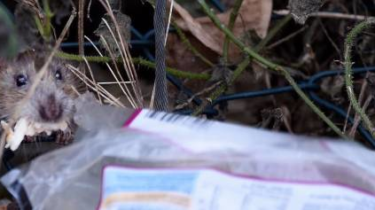Scientists have found how the rats won Australia before the first people

Most rats and rodents in Australia are the descendants of one species that moved from Asia in two waves, the first 6 million years ago and the second – a million years ago.
According to scientists, rodents, like the colonists of the past centuries, crossed the sea, clung to a floating leaf and floated down the river from the Islands of Indonesia. “They were able to cross from Indonesia to Australia in one flight,” said Stephen Scott, Professor of biology in Florida. At that time the sea level was lower, and Australia and New Guinea were part of the same land mass, so you need to cross a number of ducts. Crossing part of the road rats, probably, made the trip after a storm, as in our times, mammals are sometimes found on Board of floating vegetation, CNN writes.
See also:
In the hypermarket where the mouse has eaten sushi, the problems with rodents do not recognize
So how many rats from each subsequent wave sailed to the continent? Nobody knows, but “it may be just one pregnant female rodent,” said Stefan. If this mother is the founder survived, at least with some of its descendants, first there could be inbreeding, but in the end, individual lines can develop, which allowed for a greater variety of potential mates. This evolution, both rapid and extensive, is of interest to scientists because of its potential for practical application in medicine.
Australia to people
“Before there were rats, Australia has had a diverse animal community with a large number of different mammals, but they were all marsupials, therefore, there are kangaroos, opossums, and all of their relatives in a variety of shapes and sizes,” said Stefan.
Placental mammals, including humans, developing embryos inside their bodies, but marsupials have an external pouch. Group of reptiles and birds also joined the arriving rodents, said Emily Roycroft, Ph. D. at the University of Melbourne, which is also working on a collection of mammals in the Museum of Victoria.
See also:
Vinnyts’ka birthplace of “useful” GLB znajshla wool of first rib of grisone
In order to survive, rats have evolved to fill the role in the ecosystem, it resulted in a succession of the most diverse groups of rodents on the continent, she said.
“Before the arrival of Europeans to Australia, it is known that many of the indigenous species of rodents began to suffer massive decline in population,” said she. “Since 1850, at least 14 native species of Australian rodents have become extinct”. Next to the urbanization took the place of predators and competitors such as foxes, cats and “black rats, brown rats” and “home of mouse” .
Now, more than 50 indigenous species are impossible to find anywhere else in the world except Australia. And more than 90 species are native in New Guinea, which are also native to Southeast Asia.
Karen Roberts, Manager of data collection of vertebrate Zoology in the Museum of Victoria, said that local Australian rodents here “make up the vast majority of rodent species. Now, rats that are found in the vast Australia is genetically most closely related to the rats from Indonesia .
His Asian origins of these indigenous species associated with rodents around the world – an important detail for those who are studying them.
One big happy “Super family”
The natives are a subset of the myomorpha, the most diverse group of mammals in number of species. Stefan said: “Almost every one of the three types of mammals is a member of one group, which is a superfamily”.
See also:
In the East, soldiers in the trenches fighting the invasion of rodents
This “diverse” family includes mice, rats, hamsters, the gerbils, and many other special forms with which people are unfamiliar,” said he. Among the stranger forms meet Australian rodents, such as rats, fish, who can swim, bipedal pryguny that look like little kangaroos and rodents that live in trees and eat leaves all day.
In the end, myomorpha is a “group of mammals, which is a successful form an evolutionary point of view: they are the most diversified,” said Stephen, explaining why scientists are studying them more than other mammals.
“If we want to explain life on Earth, we need to focus on the fast-evolving groups, such as myomorpha rodents and the species in this superfamily, including the distant “Kosinov” rodent scattered across Indonesia and Australia,” said Stefan.
“All that is so diversified, could give us an idea of how everything else diversificarea”, – said the scientist.
Australia is a unique example of an isolated continent that had no type of rat while the first rat does not come from Asia. In fact, it is a laboratory for evolutionary biologists to see what happens when you have no competition, said Stefan. And what happened was very rapid diversification into many different types, large and small, are able to live in deserts and trees.
“The transition to the new territory with less competition is not explained so much as we expected,” said Stefan.
See also:
Mikolov Patera from attack Surv: grisoni, sudi
“Obviously, there are many factors that can lead to rapid diversification of one group, and actually very difficult to decipher which factor in this case is the actual explanation.
On a more practical level, understanding the evolution of this group can also help you to know more useful information about the disease,” he said.
“Some rodent species are carriers of diseases and many of these diseases actually evolved with their carriers. “
Because evolyutsioniruet rodent disease also diversificarea. Understanding the evolution of species helps us to better understand how to respond to illness – said the scientist.
At the level of basic science they “can tell us more,” said Stefan.
Saw a bug — Ctrl+Enter
Letter to the editor
© Materials
CNN
Leave your comment
Leave your comment
All comments
Always
deployed
Editor’s choice